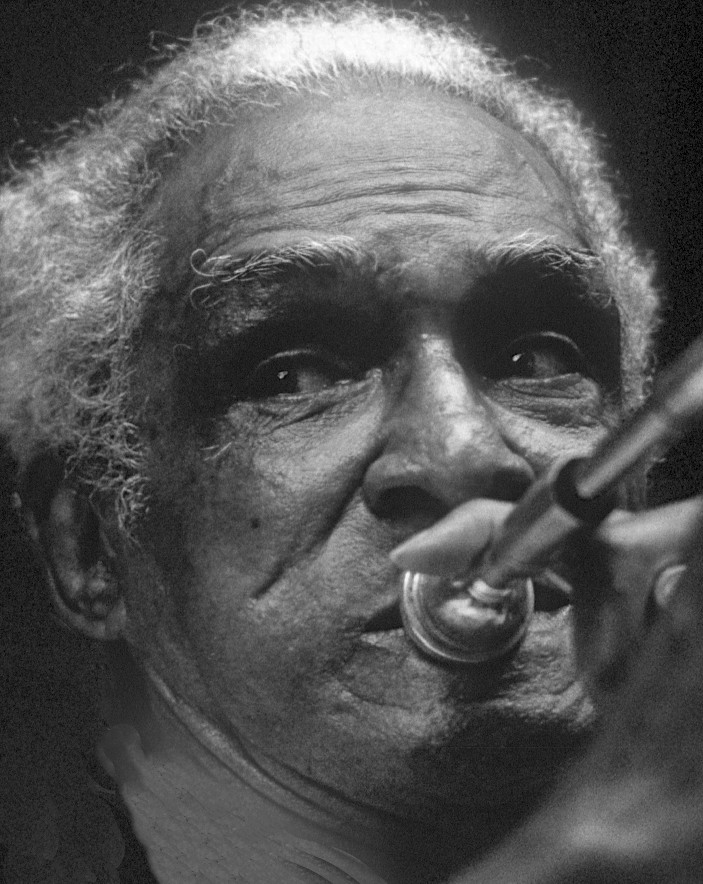Louis Nelson
Louis Nelson was a sought-after traditional jazz trombonist from New Orleans.

Courtesy of William Carter
Louis Nelson. Carter, William (Photographer)
Louis Hall Nelson was a sought-after traditional jazz trombonist from New Orleans. He toured and recorded with some of jazz’s great talents—including “Big Eye” Louis Nelson Delisle, George Lewis, Percy Humphrey, and Kid Thomas Valentine–and was a charter member of the Preservation Hall Jazz Band. A noted brass band player, Nelson performed with the Young Tuxedo, Eureka, George Williams, and Kid Howard brass bands during his long career. At the time of Nelson’s death, jazz historian Dick Allen said he was “the last personal link to the original tailgate style” of New Orleans trombone playing, a bluesy style credited to a few early jazz musicians including Kid Ory.
Nelson was born on September 17, 1902, in New Orleans into a highly educated family. His mother, Anna Hattie Adams Nelson, was a gifted pianist and a graduate of the Boston Conservatory of Music. His father, George Harry Nelson, was a physician and pianist. Shortly after Nelson’s birth, the family moved from New Orleans to the more rural Napoleonville, in Assumption Parish. Though Nelson began his musical career on valve trombone, he soon switched to slide trombone, studying with Professor Claiborne Williams of Donaldsonville. As a youth, Nelson stayed in New Orleans with Reverend Isaac H. Hall, a family friend, on weekdays so he could attend school in the city.
One of Nelson’s first professional gigs was with the influential South Louisiana fiddler Joe Gabriel and his band in Thibodaux, with whom Nelson played in rural parish dance halls. Around 1920 Nelson began playing with Kid Rena’s band. Throughout the majority of his career, Nelson supplemented his music income with driving and chauffeuring jobs.
In the late 1920s Nelson joined Sidney Desvigne’s orchestra, with whom he would play from around 1928 to 1935. Like so many other ensembles of the time, many of the Desvigne orchestra’s gigs would be aboard riverboats, and some excursions would take Nelson and Desvigne’s orchestra as far away as Minnesota. During the Great Depression, Nelson played in a Works Progress Administration (WPA) band under the direction of Pinchback Touro and Louis Dumaine. He played with the Original Tuxedo Orchestra in 1936. Nelson served in the US Navy during World War II and was promoted to musician first class while stationed at the Navy base near Memphis, Tennessee. In the mid-1940s Nelson joined Kid Thomas’s band, with whom he would play on and off for the remainder of his career.
After playing gigs on New Orleans’s West Bank and throughout the outlying parishes for many years, Nelson enjoyed a resurgence in popularity when he began gigging in New Orleans proper again. The clarinetist and bandleader George Lewis asked him to sit in with his ensemble, which led to three trips with Lewis’s band to Japan. There Nelson was recorded by the King and Victor labels. He was also one of a number of veteran musicians who were central figures at the sessions in Larry Borenstein’s French Quarter art gallery, which led to the formation of Preservation Hall.
An excellent harmony player with a mellow tone, Nelson was recorded widely during his career, first with Kid Thomas’s ensemble by Bill Russell in 1949, then later by Riverside Records with Percy Humphrey and Thomas. Nelson appeared on three of Atlantic Records’ Jazz at Preservation Hall releases and toured South America and Europe. In 1981 Nelson received a grant from the National Endowment for the Arts to teach jazz history to New Orleans public school students. At the time of his death, he was playing two nights a week at Preservation Hall and was leading his own group, The Louis Nelson All-Stars.
Nelson died on April 5, 1990, after his car was struck by a hit-and-run driver. The Olympia Brass Band led Nelson’s jazz funeral in New Orleans.
